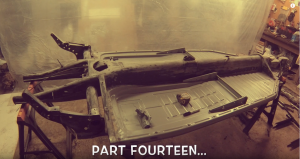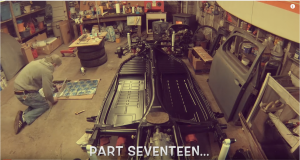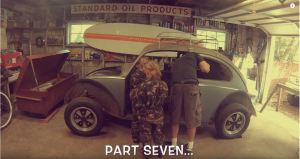Tools Needed:
There are a few tools needed for this step. Along with these tools, having a set of sawhorses is definitely helpful when working on the body panels.
- Welder – get a decent welder or borrow one from a friend (for welding in the jack supports). I have a simple flux core wire feed welder that I use for all the sheet metal work – it’s not ideal, but gets the job done. It would be nice to have something better, but they get expensive quick. Of course you’ll also probably want a welding helmet, some dikes/wire cutters, and welding hammer and gloves too. (see resources page)
- Angle Grinder with attachments – an angle grinder is one of the tools I use the most – whether using a cutting blade, wire brush wheel, flap disc, or grinding wheel – you can’t get by without one.. or at least I wouldn’t want to try getting by without one. I have a couple cheap-o grinders that I use all the time. Stock up with a few wire wheels, cutting wheels, and flap discs because you’ll use them. For this step, I used the grinding wheel and wire brush wheel. (see resources page)
- Hammer/dolly – with the body work, the idea in the beginning is to get the parts as dent free as possible so we’re not trying to slap inches of body filler on them just to make them pretty. That doesn’t last long. I would recommend investing in a decent hammer/dolly set. You don’t need anything fancy – unless you have extra money to blow. You can find a cheap set at Harbor Freight, or spend more on a higher quality set. (see resources page)
Shaping some fenders:
This is a very rough first step for the body work. I just wanted to start banging out some of the major dents in the fenders, hood, and engine lid – mainly to get an idea what will need to be done when I get to the actual detailed body work. There were also a lot of cracks in the fenders – on the edges where the fender curls over the tire, and where the bumpers go through. The thin areas had split over time and left ugly cracks and rusted areas that will need to be fixed. Here’s how I went about it:
Hammer and dolly work:
So first I started with the hammer and dolly – to get any major and noticeable dents out as much as possible. There are hammer and dolly sets specifically made for vw bugs – but I don’t have one. The idea of the hammer/dolly is to use a dolly that closely matches the panel being worked on. The dolly set that I have has a few shapes that fit very well with the contours of the bug fenders so that’s where I started. Holding the dolly behind the fender and slowly working my way around the dented areas to re-shape to as close to original as possible. While using the hammer and dolly, the areas that were cracked would start to come back to shape – lining up with how they originally looked before splitting. But of course the were still cracked and needed repair. It would be nice to have an english wheel or some better body work tools, but working with what I have.
Keep in mind, when using the hammer and dolly – it doesn’t take much. Go lightly to avoid stretching the metal more than it already is. Light taps slowly around the dented area and it’ll start coming back to shape – be patient though. If you slam the dent the opposite direction it’ll just stretch the metal and make it harder to get back into shape. There are lots of tricks with the body work – see the resources page and I’ll have some links to videos I found helpful.
Taking shape:
It takes a lot of back and forth with the hammer/dolly and welder, but eventually the parts start taking shape. The idea is using the hammer/dolly to shape the fender and get the cracked parts to line back up, then taking the welder to tie the cracks together again. Then hammer and dolly again – if any new areas begin to crack or need more attention, then little spot welds and grinding smooth until it becomes a solid almost-original shape again. Depending on whether or not the part already has body filler on it, it might take some wire brushing to see what’s actual metal, and what’s filler. Notice on one of the fenders I had to use the wire brush to remove filler and see the actual metal shape — from underneath the fender I could tell there were dents, but on top it looked smooth.
Later I’ll get the parts media blasted and do a final round of hammer/dolly/welding work before filler, but this is just a rough “blocking-in” that I like to do so I know what to expect later on. But before I get to any filler work, I’ll need to apply some fiberglass filler to cover any areas that were welded and may have pinholes that will allow moisture in. I’ll get to that in a later video.



